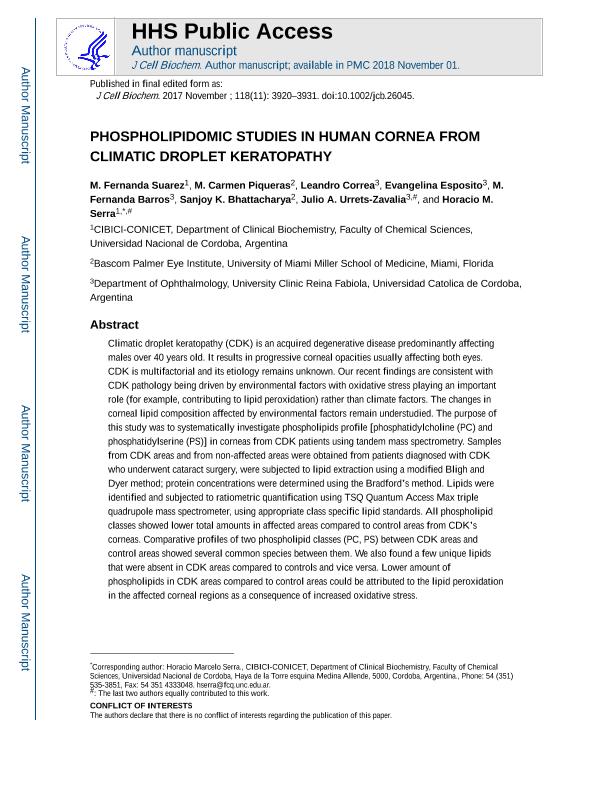Artículo
Phospholipidomic Studies in Human Cornea From Climatic Droplet Keratopathy
Suarez, Maria Fernanda ; Piqueras, Maria Carmen; Correa, Leandro Javier; Esposito, Evangelina; Barros Centeno, María Fernanda; Bhattacharya, Sanjoy K.; Urrets Zavalía, Julio Alberto; Serra, Horacio Marcelo
; Piqueras, Maria Carmen; Correa, Leandro Javier; Esposito, Evangelina; Barros Centeno, María Fernanda; Bhattacharya, Sanjoy K.; Urrets Zavalía, Julio Alberto; Serra, Horacio Marcelo
 ; Piqueras, Maria Carmen; Correa, Leandro Javier; Esposito, Evangelina; Barros Centeno, María Fernanda; Bhattacharya, Sanjoy K.; Urrets Zavalía, Julio Alberto; Serra, Horacio Marcelo
; Piqueras, Maria Carmen; Correa, Leandro Javier; Esposito, Evangelina; Barros Centeno, María Fernanda; Bhattacharya, Sanjoy K.; Urrets Zavalía, Julio Alberto; Serra, Horacio Marcelo
Fecha de publicación:
11/2017
Editorial:
Wiley-liss, Div John Wiley & Sons Inc
Revista:
Journal of Cellular Biochemistry
ISSN:
0730-2312
Idioma:
Inglés
Tipo de recurso:
Artículo publicado
Clasificación temática:
Resumen
Climatic droplet keratopathy (CDK) is an acquired degenerative disease predominantly affecting males over 40 years old. It results in progressive corneal opacities usually affecting both eyes. CDK is multifactorial and its etiology remains unknown. Our recent findings are consistent with CDK pathology being driven by environmental factors with oxidative stress playing an important role (e.g.,, contributing to lipid peroxidation) rather than climate factors. The changes in corneal lipid composition affected by environmental factors remain understudied. The purpose of this study was to systematically investigate phospholipids profile (phosphatidylcholine [PC] and phosphatidylserine [PS]) in corneas from CDK patients using tandem mass spectrometry. Samples from CDK areas and from non-affected areas were obtained from patients diagnosed with CDK who underwent cataract surgery, were subjected to lipid extraction using a modified Bligh and Dyer method; protein concentrations were determined using the Bradford's method. Lipids were identified and subjected to ratiometric quantification using TSQ Quantum Access Max triple quadrupole mass spectrometer, using appropriate class specific lipid standards. All phospholipid classes showed lower total amounts in affected areas compared to control areas from CDK's corneas. Comparative profiles of two phospholipid classes (PC, PS) between CDK areas and control areas showed several common species between them. We also found a few unique lipids that were absent in CDK areas compared to controls and vice versa. Lower amount of phospholipids in CDK areas compared to control areas could be attributed to the lipid peroxidation in the affected corneal regions as a consequence of increased oxidative stress.
Archivos asociados
Licencia
Identificadores
Colecciones
Articulos(CIBICI)
Articulos de CENTRO DE INV.EN BIOQUI.CLINICA E INMUNOLOGIA
Articulos de CENTRO DE INV.EN BIOQUI.CLINICA E INMUNOLOGIA
Citación
Suarez, Maria Fernanda; Piqueras, Maria Carmen; Correa, Leandro Javier; Esposito, Evangelina; Barros Centeno, María Fernanda; et al.; Phospholipidomic Studies in Human Cornea From Climatic Droplet Keratopathy; Wiley-liss, Div John Wiley & Sons Inc; Journal of Cellular Biochemistry; 118; 11; 11-2017; 3920-3931
Compartir
Altmétricas



